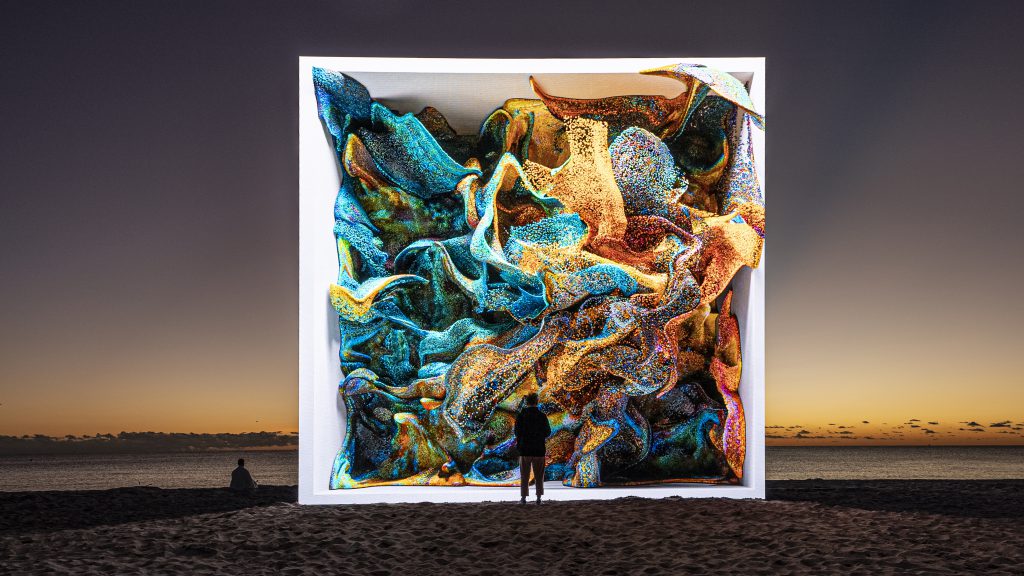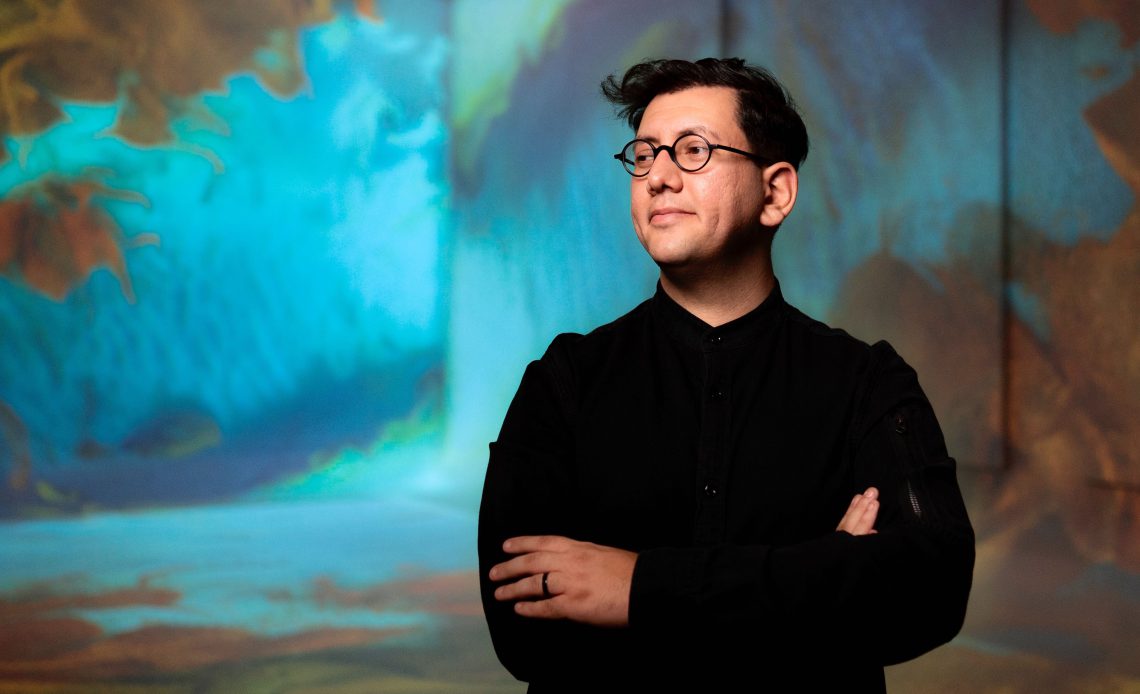The illustrious Refik Anadol has transformed both the tech and art worlds with his pioneering data paintings and sculptures. Are we now spectators to an evolving art historical legacy far beyond our imagination?
During a visit to Istanbul a few years ago, Turkish-American artist Refik Anadol was confronted with a cruel kind of loss. His uncle had just been diagnosed with Stage 1 Alzheimer’s. Anadol was shaken. Where did a relationship, a love, go if it could not be stored or remembered? How could one intervene in this disintegration, as painstaking as slowly tearing up a piece of paper?
“All I could think about was how to find a way to contain and cherish our memories together,” Anadol recalled. “I refused to admit that my uncle’s memories were disappearing, so instead imagined that they were melting, changing shape, transforming into a different material.” The result was Melting Memories (2018), an audiovisual public art performance piece by Anadol, in collaboration with the Neuroscape Laboratory at the University of California, San Francisco. The piece marked the first of the 37-year-old’s works that melded art and neuroscience. Viewers could face the data sculpture, its finely pixellated contours pouring in and out of each other like swathes of milk or molasses, and imagine time as something that could be touched or spilled. What would memory look like if it were material? What were its colours? It’s heady to imagine such difficult philosophical hypotheses being explored or manifested in an emotionally resonant way via… data. Yet this is the ‘mission’ of Anadol’s practice.
Growing up in Istanbul, Anadol got his first computer, a clunky Commodore 128, when he was eight years old. That same year, he saw the famed film Blade Runner (1982) for the first time. What the cinema and computer screens offered were alternative worlds, something beyond the ground and body towards the fantastical, the dreamt and imagined. The young Anadol began fantasising about artificial intelligence (AI) to fashion newer scenes or frontiers. Otherwise, gaming, sci-fi and film consumed his time, unknowingly sowing the seeds for the glittering career he would later construct. Along the way, he amassed two masters degrees, one at Istanbul’s Bilgi University and the second, an MFA in Design Media Arts, at UCLA, where he recently became a faculty member.

Yet it was in 2008, his last year as an undergraduate, that Anadol first felt the pivotal spark that would indelibly shape his practice. The artist and professor Koray Tahiroğlu had just delivered a lecture at Anadol’s university, on a software called Pure Data, which had a visual computing capacity. Transfixed, Anadol coined the term “data painting” in that same class, after plotting a series of sensors primarily used in physical interaction design, as if swiping a paintbrush. He asked, could data be a material or a pigment? Yes, he would go on to prove to himself. “This pigment is not the one we know that dries,” he explained in a 2020 Asian Art Newspaper interview. “This is in flux, in motion. It is in pixel format, like pixellation, using light as a material, because in my imagination when data becomes a pigment, it is not static but a living canvas.”
Evidently, the technicalities of Anadol’s methods can be complicated to grasp, especially for the average art lover. When asked to define his practice, the artist says: “I paint with a ‘thinking brush’ while reflecting on new forms of narrating the memories of humanity in physical and virtual spaces, including the blockchain. These dreams come in the forms of site-specific parametric data sculptures, live audio/visual performances, immersive installations and NFTs, which collectively offer a dramatic rethinking of our environments.” What sounds like a thick, albeit impressive, mouthful crucially points towards Anadol’s essential motivations, which are further from the machine and closer to the human. Words like ‘reflecting’, ‘narrating’, ‘memories’, ‘dreams’ and ‘dramatic’ all come under the umbrella of stories. If art is narration in any form, then Anadol’s work is about teaching, informing, coaxing machines to become vehicles of narrative. How can we use data to tell a story? How can we make a machine have an imagination? How can technology learn to ‘hallucinate’? Or dream?
Anadol’s 6.5-minute installation at Istanbul’s recently revamped Atatürk Cultural Center, entitled Rumi Dreams (2022), used an AI-based algorithm to visualise millions of manuscripts, documents, recordings and photographs from or related to the 13th-century Sufi poet’s archive and work. The 360o immersive piece was a digital imagining or ‘dream’ of Rumi’s universe. Inside the installation room, meditative whorls of colour enveloped viewers. Graphics of whirling dervishes faded in and out of the frame, as if memories flitting through consciousness. It was a breathtaking experience and an exhaustive, carefully rendered tribute to a major historical icon in Turkey. Important for Anadol, however, was conveying the impact of Rumi’s peaceful, love- and nature-driven poetry and philosophies. An active dismisser of politics, Anadol’s only stated priorities are nature and, more specifically, appealing to our collective memories to call upon our humanity. His work approaches the machine itself as a human body, attempting to connect and relate with other human bodies in dialogue.

“I don’t look at data as just numbers. I look at them as memories, as the meaningful clusters of important moments transformed into digital entities and stored in the mind of a machine,” Anadol elucidates. “When we focus on collective memories, we find something we all care about… If you detach ego from data, you are left with something very fresh and important for the future of humanity from the perspective of history-making.”
A data painting from Anadol’s Los Angeles-based lab and studio can cost between USD 20–45,000 to produce, possibly rising to half a million depending on the project’s scale. Projects are the collective labour of a team of 15 from 10 different countries – an assortment of neuroscientists, philosophers, visual artists, computer scientists and computational designers. While Anadol says that his work has received “zero negativity” – and it is relatively miniscule, skewed mainly towards asking “What is the data really doing beyond looking pretty?” – criticisms can still arise over the environmental impact of mass computation, major expenditure or ensuring data privacy. Anadol seems completely open to discussing critique, even going so far as to lengthily rebut a 2019 Medium opinion piece online. The artist claims to actively keep his studio’s carbon footprint low and also customise algorithms to ‘teach’ AI to be discerning and self-censoring in order to protect individuals’ private data.
Whether or not his assuaging responses make good on their execution, it is hard to see Anadol’s star waning anytime soon. Some have said “he is changing art history” as we speak, that he is the Leonardo da Vinci of the 21st century, a headline buttressed by a mythical-looking black-and-white portrait in his signature round-frame spectacles. He has received numerous accolades, including the Lorenzo il Magnifico Lifetime Achievement Award for New Media and Installation Art, at the age of just 33. Massive commissions have come in from places like the Charlotte Douglas International Airport, the 2021 Venice Biennale and Gaudí’s Casa Batlló in Barcelona. The heightened stardom makes Anadol harder to reach, surrounded by walls of press and busy schedules. Yet he continues to engage online and ceaselessly create newer, more ambitious projects by the day. As the ultimate goal or fantasy, Anadol dreams of inventing the “library of the future”, a work that holds all the data one could possibly gather from everything. As spectators, we wonder: is it horror or fantasy to imagine how that might look? When we teach a machine to conjure a dream, will it always be beautiful?
This profile first appeared in Canvas 105: Out of This World



